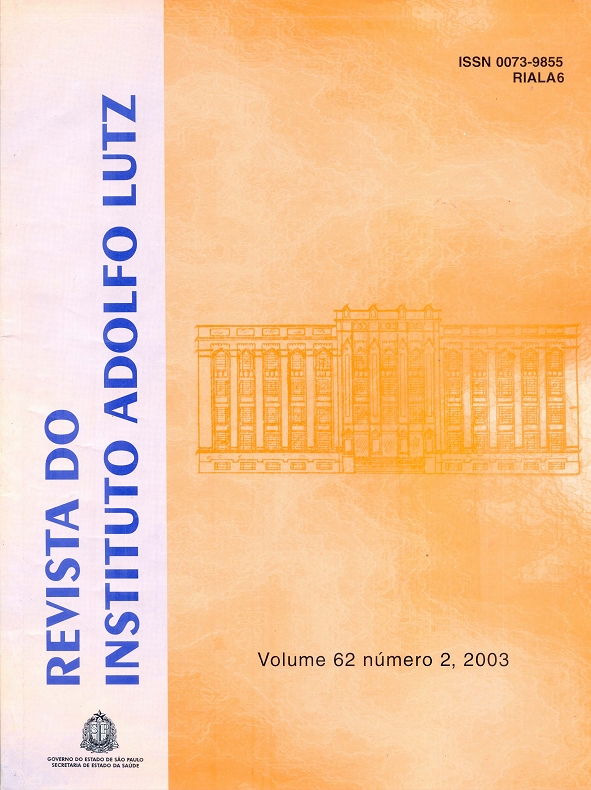Abstract
The Health National System and international organizations have given a special attention to the health workers. The goal of this study is to evaluate 38 accidents from May 1998 to May 2002 in public health laboratory, the relation with the IPEs and CPEs adequate uses or the incorrect uses by the professionals and the influence of worked time when the accident happened. The data were obtained from the accident registration organized by the biosafety staff and it was filled during the interview with the injured. The accidents were classified in five groups according to their causes: - burn (by hot, cold and acid); sharp instruments; biologic samples; samples transport and fire. Thirty eight accidents were reported involving 30 workers: 7 (18,42%) in 1998 (May to December); 10 (26,32%) in 1999; 7 (18,42%) in 2000; 7 (18,42%) in 2001 and 7 (18,42%) in 2002 (January to May). The most frequent accident (37%) occurred handling biologic samples, followed by sharp nstruments (24%). The IPE had been used incorrectly or incompletely during the 22 accidents. In biologic samples accidents, the causes were using IPEs and CPEs to around incorrectly or in incompletely way. We conclude that training prevention is very important...
References
1. Almeida, I. M. Quebra de Paradigma. Revista Produção, 125: 80-5, 2002.
2. Departamento de Saúde e Serviços Humanos dos EUA, Serviço de Saúde Pública. Biossegurança em Laboratórios Biomédicos e de Microbiologia, 4ª ed., Washington, CDC, 1999, 275p.
3. Calhoun, G. Hospitals are high-stress employers. Hospitals, p. 171-6, 1980.
4. Costa, M.A F. Qualidade em biossegurança. Rio de Janeiro, Qualitymark Ed., 2000, 116p.
5. Costa Neto, C. et al. Análise de riscos em laboratórios de saúde pública no Brasil. Livro de resumos do II Congresso Brasileiro de Biossegurança e II Simpósio Latino Americano de Produtos Transgênicos, ANBio. Salvador, BA, Brasil, p.187-8, 2001.
6. Fayel, B. J. et al. Frequency of nonparenteral occupational exposures to blood and body fluids before and after universal precautions training.Am. J. Med., 90 (2): 145-53, 1991.
7. Moreira, M. et al. Avaliação de acidentes percutâneos e percentil de soroconversão em profissionais de saúde de um hospital. Livro de resumos do Congresso Brasileiro de Controle de Infecção e Epidemiologia Hospitalar, 6. Campos do Jordão, SP, Brasil, p. 224, 1998.
8. Oda, L.M.; Ávila, S.M. et al. (org.). Biossegurança em laboratórios de Saúde Pública. 2ª ed., Brasília: Ministério da Saúde e Rio de Janeiro: Fundação Oswaldo Cruz, Brasil, 1998. 304p.
9. Siqueira, L.F.G. et al. Biossegurança em laboratórios de DST, Parte I. Rev. Bras. de Saúde Ocupacional, 65 (17):, São Paulo,1989, p.16-24.
10. Siqueira, L.F.G. et al. Biossegurança em laboratórios de DST, Parte II. Rev. Bras. de Saúde Ocupacional, 65 (17): São Paulo, 1989,p.24-32.
11. Souza, M.M. Biossegurança no laboratório clínico. Teresópolis, RJ, Livr. e Edit. Eventos, 1998, 291 p.
12. Souza, M. Acidentes ocupacionais e situações de risco para a equipe de enfermagem: um estudo em cinco hospitais do município de São Paulo. São Paulo, 1999. [Tese de Doutorado - Escola Paulista de Medicina, Universidade Federal de São Paulo].
13. Sperandio, J.C. Les processus cognitifs au cours du travail. In: Cazamian, P.; Hubault, F.; Noulin, M. Traité d’ergonomie. Toulouse: Octares Édition, 1996, p.181-90.
14. Uva, A.S. e Faria, M. Riscos Ocupacionais em hospitais e outros estabelecimentos de saúde. Edição conjunta do SIM e da FNAME, 1992

This work is licensed under a Creative Commons Attribution 4.0 International License.
Copyright (c) 2003 Revista do Instituto Adolfo Lutz
